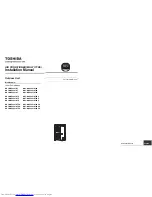
– 11 –
Airtight test
After the refrigerant piping has finished, execute an airtight test.
For an airtight test, connect a nitrogen gas bomb as shown in the figure below, and apply pressure.
• Be sure to apply pressure from the service ports of the packed valves (or ball valves) at liquid side, discharge gas side, and
suction gas side.
• An air tight test can be only performed to the service ports at liquid side, discharge gas side, and suction gas side of the
outdoor unit.
• Close fully valves at liquid side, discharge gas side, and suction gas side. As there is possibility that nitrogen gas enters in
the refrigerant cycle, re-tighten the valve rods before applying pressure.
(Re-tightening of the valve rods are unnecessary for valves at discharge gas side because they are ball valves.)
• For each refrigerant line, apply pressure gradually with steps at liquid side, discharge gas side, and suction gas side.
Be sure to apply pressure to suction gas side, discharge gas side, and liquid side.
REQUIREMENT
Never use “Oxygen”, “Flammable gas” and “Noxious gas” in an airtight test.
Leaked position check
When a pressure-down is detected in STEP 1, STEP 2, or STEP 3, check the leakage at the connecting points. Check leakage
with hearing sense, feeler, foaming agent, etc, and perform re-brazing or re-tightening of flare if leakage is detected.
STEP 1:
Apply pressure 0.3 MPa (3.0 kg/cm2G) for 3 minutes or more.
⎞
Available to detect a gross leakage
STEP 2:
Apply pressure 1.5 MPa (15 kg/cm2G) for 3 minutes or more.
⎠
STEP 3:
Apply pressure 3.73 MPa (38 kg/cm2G) for approx. 24 hours.
Available to detect slow leakage
• Check pressure down.
No pressure down: Accepted Pressure down: Check the leaked position.
⎛
However, if there is difference of ambient temp. between when pressure has been applied and when 24 hours passed,
pressure changes by approx. 0.01 MPa (0.1 kg/cm²G) per 1°C. Correct the pressure.
⎞
⎝
⎠
VL
VH
Connected to indoor unit
Packed valve fully closed
(Gas side)
Outdoor unit
Service port
Ø6.4
Copper pipe
Brazed
High-
pressure
gauge
Low-
pressure
gauge
Gauge
manifold
Ball valve fully closed
(Liquid side)
Service port
Ø6.4
Copper pipe
Nitrogen gas
Main pipe
Fully closed
Reducing
valve
Air purge
NOTE
For the air purge at installation time (Discharge of air in connecting pipes), use “
Vacuum pump method
” from viewpoint of the
protection of the earths environment.
• For protection of the earth environment, do not discharge the refrigerant gas in the air.
• Using a vacuum pump, eliminate the remaining air (nitrogen gas, etc.) in the unit.
If gas remains, performance and reliability of the unit may be reduced.
After the airtight test, discharge nitrogen gas. Then connect the gauge manifold to the service ports at suction gas side,
discharge gas side and liquid side, and connect the vacuum pump as shown in the following figure.
Be sure to perform vacuuming for suction gas side, discharge gas side and liquid side.
• Be sure to perform vacuuming from both suction gas side, discharge gas side and liquid side.
• Be sure to perform vacuuming from both liquid and gas sides.
• Use a vacuum pump with counter-flow preventive function so that oil in the pump does not back up in the pipe of the air
conditioner when the pump has been stopped. (If oil in the vacuum pump enters in to the air conditioner with R410A
refrigerant, an error may occur in the refrigeration cycle.)
• Use a vacuum pump that has a high vacuum (below -755 mmHg) and a large exhaust gas amount (over 40L / minute).
• Perform vacuuming for 2 or 3 hours though time differs due to pipe length.
In this time, check all packed valves at liquid, gas and balance sides are fully closed.
• If vacuuming valve amount is not decreased to below -755 mmHg even after vacuuming for 2 hours or more, continue
vacuuming for 1 hour or more.
If -755 mmHg or less cannot be obtained by 3 hours or more vacuuming, detect and repair the leak.
• When the vacuuming valve has reached -755 mmHg or less after vacuuming for 2 hours or more, close valves VL and VH
on the gauge manifold fully. Stop the vacuum pump, leave it as it is for 1 hour and then check the vacuum does not change.
If it does change then there may be a leak within the system.
• After the above procedure for vacuuming has finished, exchange the vacuum pump with a refrigerant cylinder and advance
to the additional charging of refrigerant.
P
VL
VH
Connected to indoor unit
Packed valve fully closed
(Gas side)
Outdoor unit
Service port
Brazed
Ball valve fully closed
(Liquid side)
Service port
Main pipe
Fully closed
High-
pressure
gauge
Low-
pressure
gauge
Gauge manifold
Vacuum pump
21-EN
22-EN













































